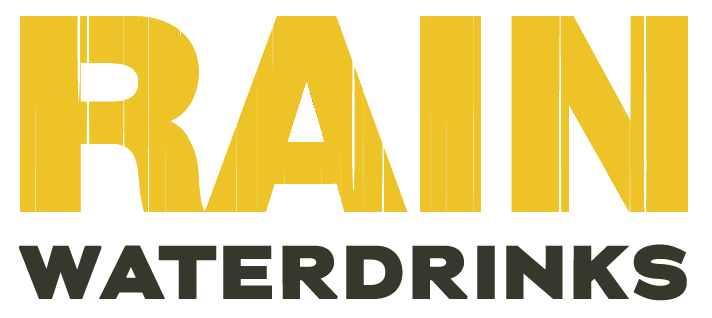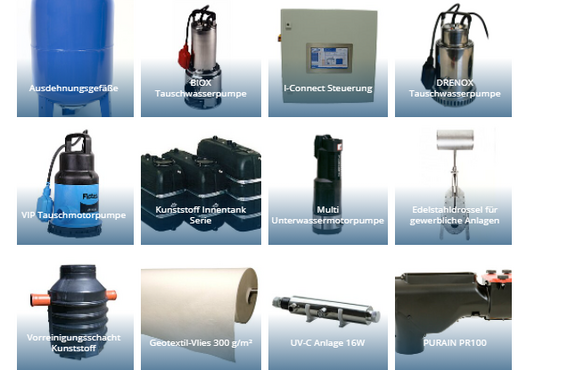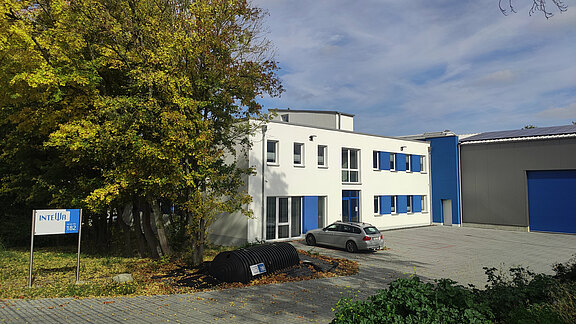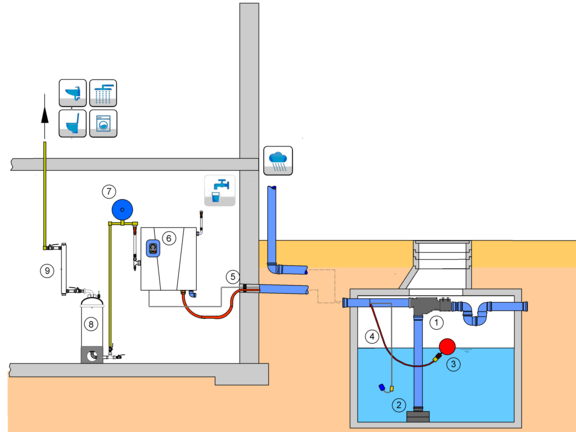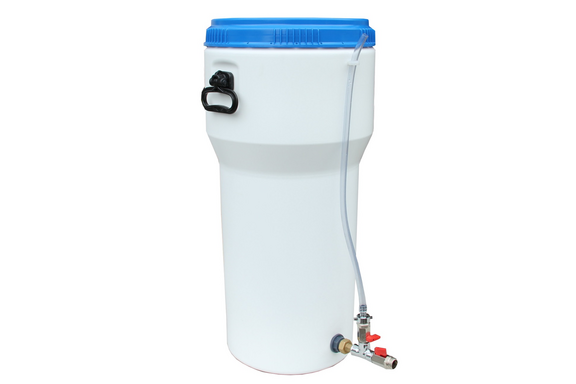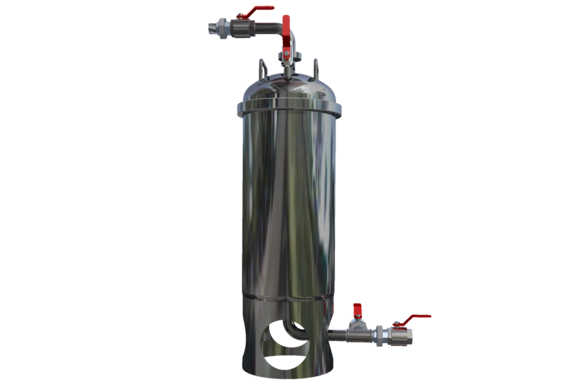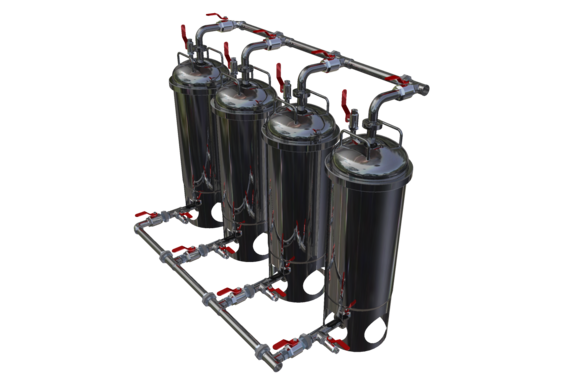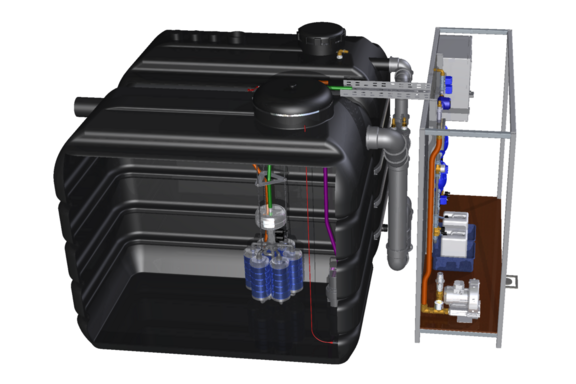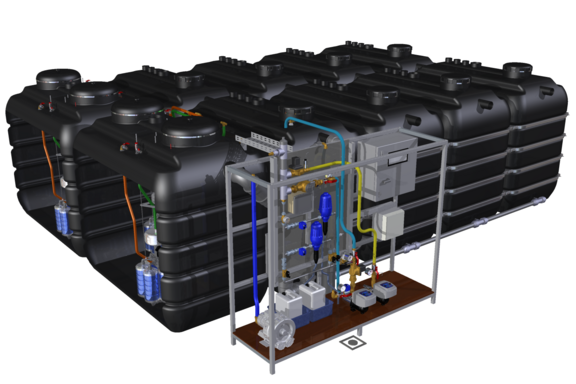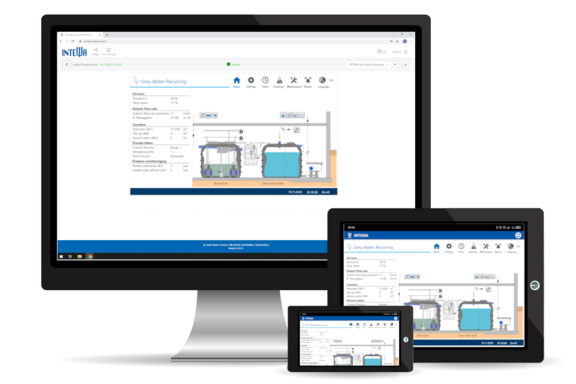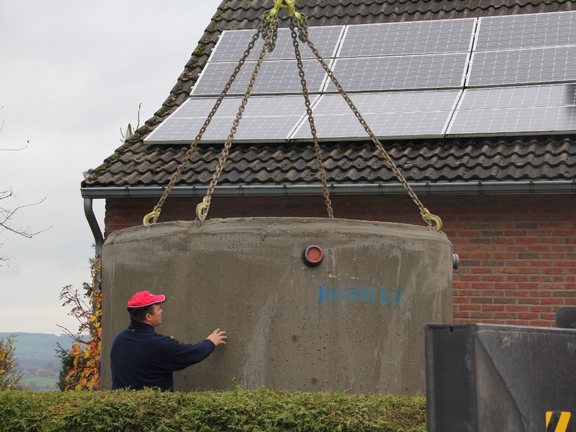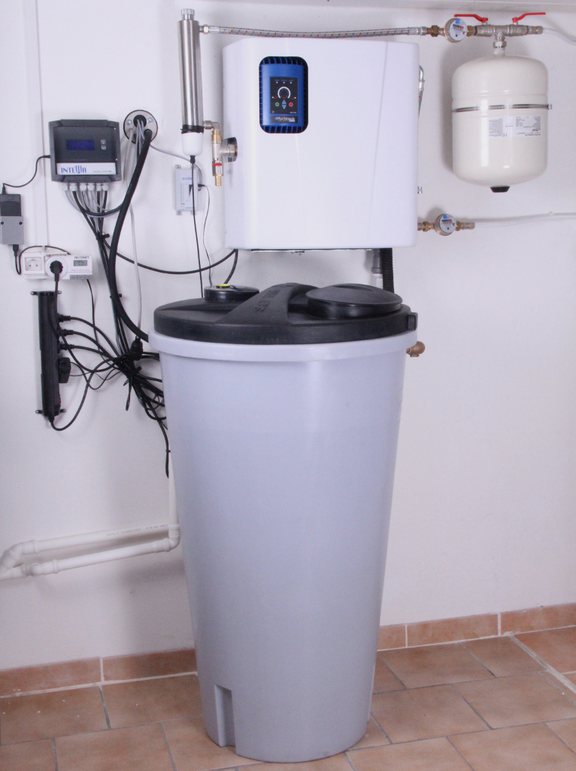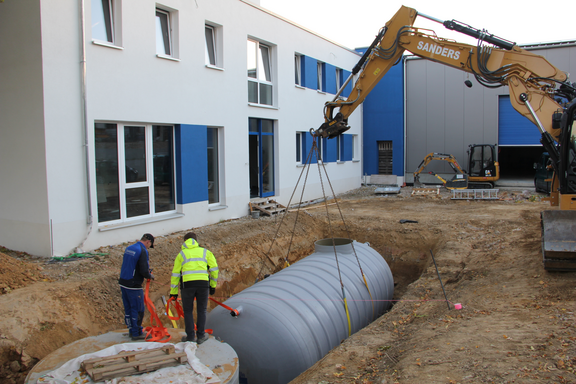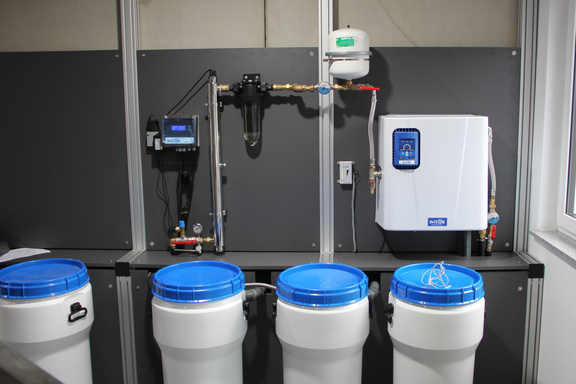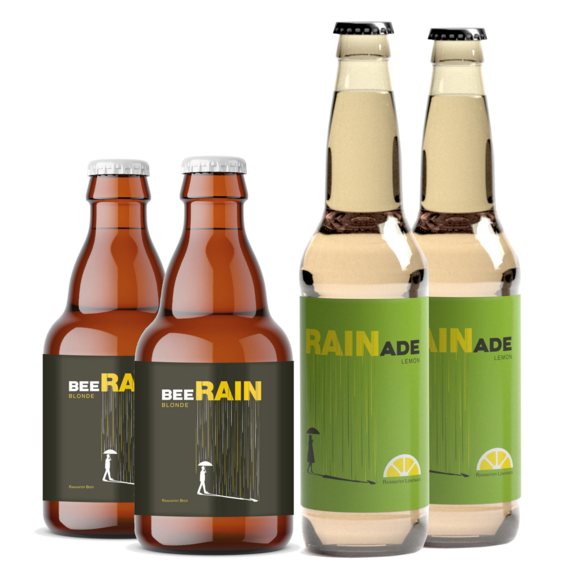Drinking water from rainwater - decentralized systems, experiences, possibilities and barriers
In the context of the new DIRECTIVE (EU) 2020/2184 OF THE EUROPEAN PARLIAMENT AND OF THE COUNCIL of December 16, 2020 on the quality of water intended for human consumption.
The drinking water supplier delivers high-quality, monitored water from centralized systems at all times. At least that's what we're used to in Germany. So why worry about a decentralized rainwater supply? Water shortages, quality problems, a contribution to flood protection and protection of natural drinking water sources are just some of the reasons. Even in Germany, the first natural wells have dried up in recent years. The situation in many European countries is worrying in some cases. More and more countries are reporting supply shortages during dry periods. In Belgium and the Netherlands, the major water suppliers are actively looking for new sources of water because they are temporarily unable to meet demand. Decentralized rainwater harvesting systems, which not only treat the water to so-called process water quality (DIN EN 16941-1), but also to drinking water quality, can help to close these growing supply gaps. This technical article provides an insight into the basics and solution approaches as well as examples of implemented systems.
Advantages and disadvantages of rainwater as a water source for drinking water supply
In Germany, around 13 % of drinking water currently comes from lakes, reservoirs or river water; around 70 % comes from groundwater or springs. In principle, rainwater is therefore already an integral part of the drinking water supply. One of the main advantages of using rainwater is that it is environmentally friendly. Piping systems and energy can be saved and dwindling drinking water resources can be conserved. Decentralized rainwater storage tanks also contribute to rainwater management, including flood protection. Furthermore, cost savings can be achieved through the collection and use of rainwater. The easy availability of rainwater as a renewable resource is also a positive aspect. However, it is heavily dependent on climatic conditions. Due to the increasingly longer dry periods caused by climate change, rainwater cisterns also need to be larger if self-sufficiency, i.e. independence from the water supplier, is the aim. A major advantage of rainwater is its good basic quality, as the first treatment stage is already carried out automatically by the previous evaporation in the atmosphere, which is extremely good and even completely free of charge. There is no cheaper filter. Rainwater is also free of numerous trace substances, such as drug residues. On the other hand, there are challenges that need to be considered when using rainwater. The inconsistent availability in dry periods or regions with irregular rainfall is a disadvantage. In addition, water quality must be carefully monitored and ensured through filtration and treatment. The infrastructure required for the installation of rainwater collection systems can be costly and space-intensive. There is also a dependency on roofing materials, as certain materials can release potentially harmful substances. Overall, the decision to use rainwater as a source of drinking water requires a comprehensive assessment of local conditions, available resources and the necessary infrastructure measures. Once this decision to use roof runoff water for a project has been made, the requirements of the national drinking water regulations in Europe must be followed. These in turn are based on the European Directive (EU) 2020/2184 on the quality of water intended for human consumption. As described in Article (2) of (EU) 2020/2184, this applies to water regardless of its origin, i.e. also to so-called roof run-off water.
DIRECTIVE (EU) 2020/2184 on the quality of water intended for human consumption
eur-lex.europa.eu/legal-content/DE/ALL/
After some criticism and revision, the new DIRECTIVE (EU) 2020/2184 OF THE EUROPEAN PARLIAMENT AND OF THE COUNCIL of December 16, 2020 on the quality of water intended for human consumption finally came into force on January 12, 2021. The objective is described in Article (1):
"This Directive concerns the quality of water intended for human consumption for all in the Union.
(2. The objectives of this Directive are to protect human health from the adverse effects arising from the contamination of water intended for human consumption by ensuring its wholesomeness and purity and to improve access to water intended for human consumption."
Water intended for human consumption is defined in Article 2 as follows:
"(a) all water, whether in its natural state or after treatment, intended for drinking, cooking, food preparation or other domestic uses in both public and private premises, irrespective of its origin and whether it is supplied from a distribution network or in tankers or bottled or otherwise contained, including spring water,
(b) all water used in a food business for the manufacture, treatment, preservation or placing on the market of products or substances intended for human consumption,'
Various exceptions are defined under Article (3). For example, the Directive does not apply to recognized natural mineral waters. Member States can also allow exemptions from the Directive themselves:
"(a) water intended exclusively for uses in respect of which the competent authorities are satisfied that the quality of the water has no direct or indirect effect on the health of the consumers concerned;
b) water for human consumption from an individual supply system from which on average less than 10 m³ per day is drawn or which supplies less than 50 persons, provided that the water is not supplied as part of a commercial or public activity."
The following exception also applies to small water suppliers:
"Water suppliers supplying less than 10 m³ per day on average in the course of a commercial or public activity or supplying less than 50 persons shall be subject only to Articles 1 to 6 and Articles 13, 14 and 15 and the relevant Annexes to this Directive. "
On the one hand, this means that the drinking water regulations of the individual member states will continue to differ. On the other hand, the new directive also allows for more opportunities to diversify the drinking water supply. Articles 7-10 contain provisions on the so-called "risk-based approach" and its implementation. Member States are to ensure that a risk-based approach is applied to the supply, treatment and distribution of water intended for human consumption, covering the entire supply chain from the catchment area to the abstraction, treatment, storage and distribution of water at the point of use. The EU directive had to be implemented by 12.01.2026 in addition to some extended transitional periods (e.g. PFAS).
In Germany, the revised Drinking Water Ordinance came into force on June 24, 2023, implementing key elements of the EU Drinking Water Directive from 2020. "The revised Drinking Water Ordinance (TrinkwV) provides for the introduction of risk-based drinking water protection, introduces new parameters and sets lower limits for pollutants such as chromium, arsenic and lead. Operators of water supply systems are obliged to decommission or replace old lead pipes."
https://www.bundesgesundheitsministerium.de/service/begriffe-von-a-z/t/trinkwasser
Authorization
There are very large differences in the countries of the EU with regard to the approval of decentralized systems for drinking water supply using roof run-off water as a source. Uncertainty exists initially, as there is no specific normative regulation or even a test standard for this technology. In principle, however, just like a well system, it is a so-called self-supply system, which is not prohibited under the drinking water supply regulations. With regard to the technology, installation and use of a drinking water self-supply system, there are definitions in the German and European Drinking Water Ordinance, according to which the health authorities make their decisions on approval and thus provide specifications for testing the water quality. Since 2016, various practical examples have shown that health authorities have very different opinions on the subject of drinking water from roof run-off water, surface water and well water. There are health authorities that consider such decentralized self-supply systems to be good and also tolerate them after communicating with the manufacturer and private customers. There are very different specifications from the individual health authority employees, whereby the quality of the water must and should be tested at various intervals after treatment. Often, the mostly verbal specifications are around 7-10 parameters, whereby these are primarily the test parameters for pathogens, as roof run-off water does not exceed the limit values of the Drinking Water Ordinance for any dissolved substances in corresponding roof materials, depending on the region and country. When treating surface water or groundwater, such as well water or stream water, test parameters such as nitrate, nitrite, manganese, iron and minerals are also specified, which are then tested at regular intervals. Even with the approval or toleration of the public health department, the municipality can insist on the obligation to connect and use water, which has existed in Germany since 1935 (de.wikipedia.org/wiki/Anschluss-_und_Benutzungszwang), provided that the building can be connected to the water network. This may mean that a building must be connected to the central water supply but does not draw any water from there. This is regulated in the bylaws of the municipalities. In many other European countries, however, the obligation to connect and use water is not known. In contrast to the obligation to connect, the obligation to use is not yet enforced in any known system. However, an exact minimum volume of municipal water is not clearly defined either.
With self-supply systems, which are installed as a supplement to the municipal water connection, the connection obligation is fulfilled and drinking water from the municipal water supply is also used during dry periods (empty cistern). The volume of rainwater stored in a cistern relieves the drinking water supplier during longer dry periods, especially in areas (also in Germany) where garden irrigation is prohibited due to water shortages. During heavy rainfall events, the remaining empty portions of the cisterns relieve the rainwater sewers. The first local authorities have also recognized this. From 01.01.2024, Berliner Wasserbetriebe will only charge 10% of the rainwater fees if rainwater is used as process water in the building.
System technology
With the AQUALOOP drinking water from rainwater series, INTEWA has now developed a complete series of ready-to-connect systems with a treatment volume of 1000 - approx. 86,400 l/day and multiples thereof. The Aachen-based company has already investigated, sampled, optimized and successfully implemented the technology in numerous projects over the last 10 years. In the following section, the functional principle is explained using the example of a single-family house system AL-DW1000 RMF-40 SC with RMF-SC 40 pumping station.
The so-called "roof run-off water" is first pre-filtered via a PURAIN ① pre-filter before it enters the cistern.
The rainwater cistern is usually installed outside the building as an underground storage tank. Depending on the size of the system, concrete cisterns or plastic storage tanks are usually considered. As the roof run-off water in the cisterns has a longer residence time and therefore contact time with the material, care must be taken to ensure that no pollutants can enter the water via the cistern walls. In the case of plastic storage tanks, the suppliers should have certificates or declarations of conformity regarding the suitability of the material for food storage.
The skimmer overflow of the PURAIN filter removes surface contamination. The integrated backwater flap prevents small animals and dirt from entering the cistern. The calming pot ② prevents soil sediment from being stirred up. The RAINMASTER Favorit 40-SC pump system ⑥ draws the rainwater from the cistern via a suction pipe ④ with floating suction filter ③ and presses it through the AQUALOOP-direct ultrafiltration unit ⑧. Due to the small membrane pore size of 0.02 µm, particles, bacteria and even viruses are retained. Pressure surges are buffered via an expansion vessel ⑦. After this membrane filtration, the water passes through an additional UV unit ⑨ for redundant disinfection before it reaches the consumers. When a consumer such as toilets, washing machines, showers, bathtubs, washbasins, and the garden system is opened, the pump unit automatically detects a drop in pressure and starts. If there is not enough rainwater available, the RAINMASTER Favorit 40-SC automatically supplies the consumers with drinking water via an integrated, DVGW-certified make-up water supply.
In areas with particularly high levels of air pollution, additional treatment stages may be necessary or useful:
Reverse osmosis (RO)
Adsorption (activated carbon) to remove dissolved substances and
Flavour neutralization
Point-of-use (POU) filter (in front of the kitchen tap)
Whether one of the additional treatment stages is required must be determined after installation and verification of the water quality achieved. Whether such a system is economically viable depends on numerous factors. This question only arises if sufficient water is available as an alternative from the drinking water supplier. A single-family home system can be realized for less than € 10,000.00. With a water consumption of approx. 190 m³ / year for a 4-person household and water costs of € 3.00/m³, for example, € 570.00/year could be saved. Added to this are costs for operation and water analysis of between €150.00 and €300.00 per year. The filtration has a life expectancy of > 10 years without replacement materials. In areas with hard water, a softening system can be dispensed with for over €3,000.00 and more than €150.00/year in operating costs. If the connection fee can be waived, several thousand euros can be saved. In remote areas, the connection fee can even be significantly more expensive than a separate rainwater system. In the case of commercial systems, the system costs are much lower in relative terms, meaning that profitability can be achieved more quickly. The following table provides an overview of different system sizes, each without a rainwater cistern:
Table 1: Overview of AQUALOOP drinking water from rainwater system series
| Designation | Description
|
|---|---|
| AL-Tap1600 |
|
AL DW1000
|
|
AL-DW3000 AL-DW6000 |
|
AL-DW9600 AL-DW19200 AL-DW28800 AL-DW38400 AL-DW57600 AL-DW86400 |
|
Monitoring, operation and maintenance with I-CONNECT
A central point in the decentralized treatment of roof runoff water to drinking water quality is monitoring. Systems larger than 9600 l/day are already equipped with the I-CONNECT control system for this purpose. It enables remote monitoring. The respective system can be accessed online via a web portal or an app. In the future, it is also planned to monitor the water quality online wherever possible. This is currently done via laboratory analyses.
Reference systems
Retrofit in a detached house in Kelmis, Belgium
Retrofitting was possible for this project as the existing pipe system could be used.
Collecting rainwater from 120 m² of roof area
Storage in a 10 m³ outdoor cistern
AQUALOOP membrane station with ultrafiltration in cistern
350 liter clear water tank in the cellar for sterilized water
Withdrawal from clear water storage tank with RAINMASTER-Favorit 20-SC
UV sterilization with 20 watts for additional safety
Pressure increase in existing pipe system
Connection to shower, washing machine, hand basin etc.
Drinking water replenishment via RAINMASTER with city water
Water quality of the rainwater
The quality of the rainwater and the cleaning performance of the system were examined by taking samples at various points in the overall system. The analysis results show that the bacterial contamination of the raw water from the rainwater cistern is already very low. Neither the bacterium E. coli, an important indicator of contamination with faeces, nor the pathogen Pseudomonas aeruginosa could be found in the samples. After AQUALOOP ultrafiltration, no more coliform bacteria or bacterial colonies could be detected. Additional disinfection using the UV lamp provides additional safety. The limit values of the Drinking Water Ordinance for "water intended for human consumption" were complied with for all parameters tested (see Table 1). Only the pH value was exceeded during the first sampling. The reason for this was an alkaline sludging of the concrete cistern with cement due to a repair measure.
Table 2: Analysis results of the AQUALOOP rainwater system, 1.4.2014 , source: Institut für Wasser- und Abwasseranalytik GmbH.
Parameters
| Unit | Limit value (according to TVO) 2014 | Rainwater | Treatment by AQUALOOP |
Escherichia coli | /100ml | 0 | 0 | 0 |
Enterococci | /100ml | 0 | 0 | 0 |
Coliform bacteria | /100ml | 0 | 2 | 0 |
Colony count 22 °C | /ml | 100 | 11 | 0 |
Colony count 36°C | /ml | 100 | 12 | 0 |
Pseudomonas Aeruginosa | /100ml | -- | 0 | 0 |
TOC | mg/l | -- | 3mg/l | 2,8 mg/l |
Calcium | mg/l | 22,4 | ||
Magnesium | mg/l | <0,5 | ||
Conductivity at 25°C | μs/cm | 2790 | 215 | |
Copper | mg/l | 2 | 0,008 |
INTEWA headquarters Aachen
At the company headquarters in Aachen, INTEWA collects the run-off water from the hall roof in a 30 m³ food-safe glass fiber storage tank in order to treat drinking water for the company using AQUALOOP technology. The water is regularly sampled by a recognized laboratory in accordance with the TVO. The cistern is also used as a retention tank for heavy rainfall events.
| Rainwater yield from hall roof: | approx. 380 m³ / year |
| Rainwater consumer: | approx. 90 m³/year |
| Usage: | Water, coffee, tea, hand basin Sink, dishwasher, cleaning Beer and lemonade |
Thanks to the large roof area, the company is self-sufficient in water.
As there is still rainwater left over, it was considered how it would be possible to spread awareness of the decentralization of rainwater use and make it accessible to more people. The idea was born to produce beer and lemonade, "beeRAIN" and "RAINade" from the treated rainwater. beeRAIN and RAINade are not industrially produced beverages, but drinks that are produced to the highest standards in small craft breweries in Belgium. The treated roof run-off water is transported to the nearby brewery in a tanker. The RAINwaterdrinks are sold to customers at cost price. However, production quantities are very limited.
Rimac, Croatia
The first large industrial plant was delivered in December 2023 for the Rimac plant in Nevera, with a treatment volume of 100 m³/day. Its task is to produce drinking water from rainwater in the Rimac industrial park and in electric car production. Before the water enters the cistern, it is pre-cleaned by the PURAIN filter. A Biox pump pumps the rainwater from the rainwater tank into the AQUALOOP membrane tanks. These are equipped with 11 membrane stations consisting of 66 membrane cartridges. The system supplies up to 100 m³ of treated roof runoff water per day. The UV system installed in the pressure pipe is used for additional disinfection of the water before it is passed on to the consumer fittings via the pump system (PROFI).
Summary and outlook
In more and more countries in the European Union, drinking water supplies from groundwater, rivers and lakes are becoming temporarily scarcer due to climate change. Even in Germany, the first natural wells have dried up in recent years. End users and water suppliers are looking for new sources of water and have rediscovered roof run-off water. With suitable treatment methods, this former rainwater can be treated to drinking water quality in decentralized rainwater harvesting systems and can make a valuable contribution to closing these growing supply gaps. The new DIRECTIVE (EU) 2020/2184 OF THE EUROPEAN PARLIAMENT AND OF THE COUNCIL on the quality of water intended for human consumption, which finally came into force on 12.01.2021, describes the requirements for the required quality of this water. With a new series of ready-to-connect systems, water expert INTEWA from Aachen shows that this form of decentralized drinking water production from roof run-off water is now technologically feasible and is even suitable for retrofitting. The oldest systems implemented to date have been running stably and safely for over 10 years now. In current research and development projects, online sensor technology in particular is being further developed to enable water quality to be monitored remotely and to further expand the important component of "rainwater harvesting" to secure the water supply.
Author: Oliver Ringelstein, INTEWA GmbH
Further information:
- Beer and lemonade from rainwater
- Potable water from rainwater references
- Potable water from rainwater at INTEWA
- Virtual 360° exhibition
- Basic knowledge water treatment
- Free online planning tools

